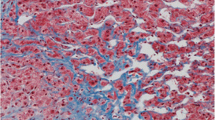Abstract
The Fontan procedure has significantly improved the survival rates of those born with univentricular congenital heart disease. In doing so, patients are left with a chronically elevated central venous pressure and reduced cardiac output. This leads to a spectrum of hepatic dysfunction known as Fontan-associated liver disease (FALD). FALD is progressive, with the risk and therefore incidence of cirrhosis and hepatocellular carcinoma (HCC) increasing over time. This necessitates accurate diagnostic and prognostic assessment. Biochemical markers, non-invasive fibrosis scores, radiological imaging, elastography and liver biopsy are all used in screening, diagnosis and surveillance of FALD, but without national guidelines or validated diagnostic thresholds to follow. Treatment of FALD relies on non-specific medical therapies and consideration of combined heart–liver transplantation. Clearly, further research in the form of large-scale longitudinal studies is vital to provide a stronger evidence basis for all aspects of care for these patients. Validated tools, standardised guidelines and clear referral pathways are yet to be determined. With such progress, we can harmonise the management of FALD and continue to improve patient outcomes.
Access this chapter
Tax calculation will be finalised at checkout
Purchases are for personal use only
Similar content being viewed by others
References
Diamond T, Ovchinsky N. Fontan-associated liver disease: monitoring progression of liver fibrosis. Clin Liver Dis. 2018;11(1):1. https://doi.org/10.1002/cld.681. https://pubmed.ncbi.nlm.nih.gov/30992779/.
Emamaullee J, Zaidi AN, Schiano T, Kahn J, Valentino PL, Hofer RE, Taner T, Wald JW, Olthoff KM, Bucuvalas J, Fischer R. Fontan-associated liver disease: screening, management, and transplant considerations. Circulation. 2020;142(6):591–604. https://doi.org/10.1161/circulationaha.120.045597.
Further Readings
Clift P, Celermajer D. Managing adult Fontan patients: where do we stand? Eur Respir Rev. 2016;25(142):438–50.
Pundi K, Pundi KN, Kamath PS, Cetta F, Li Z, Poterucha JT, Driscoll DJ, Johnson JN. Liver disease in patients after the Fontan operation. Am J Cardiol. 2016;117(3):456–60.
Rychik J, Veldtman G, Rand E, Russo P, Rome JJ, Krok K, Goldberg DJ, Cahill AM, Wells RG. The precarious state of the liver after a Fontan operation: summary of a multidisciplinary symposium. Pediatr Cardiol. 2012;33(7):1001–12.
Simpson KE, Esmaeeli A, Khanna G, White F, Turnmelle Y, Eghtesady P, Boston U, Canter CE. Liver cirrhosis in Fontan patients does not affect 1-year post-heart transplant mortality or markers of liver function. J Heart Lung Transplant. 2014;33(2):170–7.
Nandwana SB, Olaiya B, Cox K, Sahu A, Mittal P. Abdominal imaging surveillance in adult patients after Fontan procedure: risk of chronic liver disease and hepatocellular carcinoma. Curr Probl Diagn Radiol. 2018;47(1):19–22.
Gordon-Walker TT, Bove K, Veldtman G. Fontan-associated liver disease: a review. J Cardiol. 2019;74(3):223–32.
Wu FM, Ukomadu C, Odze RD, Valente AM, Mayer JE Jr, Earing MG. Liver disease in the patient with Fontan circulation. Congenit Heart Dis. 2011;6(3):190–201.
Baek JS, Bae EJ, Ko JS, Kim GB, Kwon BS, Lee SY, Noh CI, Park EA, Lee W. Late hepatic complications after Fontan operation; non-invasive markers of hepatic fibrosis and risk factors. Heart. 2010;96(21):1750–5.
Elder RW, McCabe NM, Hebson C, Veledar E, Romero R, Ford RM, Mahle WT, Kogon BE, Sahu A, Jokhadar M, McConnell ME. Features of portal hypertension are associated with major adverse events in Fontan patients: the VAST study. Int J Cardiol. 2013;168(4):3764–9.
Bae JM, Jeon TY, Kim JS, Kim S, Hwang SM, Yoo SY, Kim JH. Fontan-associated liver disease: spectrum of US findings. Eur J Radiol. 2016;85(4):850–6.
Surrey LF, Russo P, Rychik J, Goldberg DJ, Dodds K, O'Byrne ML, Glatz AC, Rand EB, Lin HC. Prevalence and characterization of fibrosis in surveillance liver biopsies of patients with Fontan circulation. Hum Pathol. 2016;57:106–15.
Wells ML, Fenstad ER, Poterucha JT, Hough DM, Young PM, Araoz PA, Ehman RL, Venkatesh SK. Imaging findings of congestive hepatopathy. Radiographics. 2016;36(4):1024–37.
Dijkstra H, Wolff D, van Melle JP, Bartelds B, Willems TP, Oudkerk M, Hillege H, van den Berg AP, Ebels T, Berger RM, Sijens PE. Diminished liver microperfusion in Fontan patients: a biexponential DWI study. PLoS One. 2017;12(3):e0173149.
Poterucha JT, Johnson JN, Qureshi MY, O’Leary PW, Kamath PS, Lennon RJ, Bonnichsen CR, Young PM, Venkatesh SK, Ehman RL, Gupta S. Magnetic resonance elastography: a novel technique for the detection of hepatic fibrosis and hepatocellular carcinoma after the Fontan operation. Mayo Clin Proc. 2015;90(7):882–94.
Myers RP, Cerini R, Sayegh R, Moreau R, Degott C, Lebrec D, Lee SS. Cardiac hepatopathy: clinical, hemodynamic, and histologic characteristics and correlations. Hepatology. 2003;37(2):393–400.
European Association For The Study Of The Liver. EASL–EORTC clinical practice guidelines: management of hepatocellular carcinoma. J Hepatol. 2012;56(4):908–43.
Possner M, Gordon-Walker T, Egbe AC, Poterucha JT, Warnes CA, Connolly HM, Ginde S, Clift P, Kogon B, Book WM, Walker N. Hepatocellular carcinoma and the Fontan circulation: clinical presentation and outcomes. Int J Cardiol. 2021;322:142–8.
Daniels CJ, Bradley EA, Landzberg MJ, Aboulhosn J, Beekman RH, Book W, Gurvitz M, John A, John B, Marelli A, Marino BS. Fontan-associated liver disease: proceedings from the American College of Cardiology Stakeholders Meeting, October 1 to 2, 2015, Washington DC. J Am Coll Cardiol. 2017;70(25):3173–94.
Author information
Authors and Affiliations
Corresponding author
Editor information
Editors and Affiliations
Rights and permissions
Copyright information
© 2022 Springer Nature Switzerland AG
About this chapter
Cite this chapter
Asad, H., Chaudhry, T.P., Jenkins, P. (2022). Fontan-Associated Liver Disease (FALD). In: Cross, T. (eds) Liver Disease in Clinical Practice. In Clinical Practice. Springer, Cham. https://doi.org/10.1007/978-3-031-10012-3_15
Download citation
DOI: https://doi.org/10.1007/978-3-031-10012-3_15
Published:
Publisher Name: Springer, Cham
Print ISBN: 978-3-031-10011-6
Online ISBN: 978-3-031-10012-3
eBook Packages: MedicineMedicine (R0)




